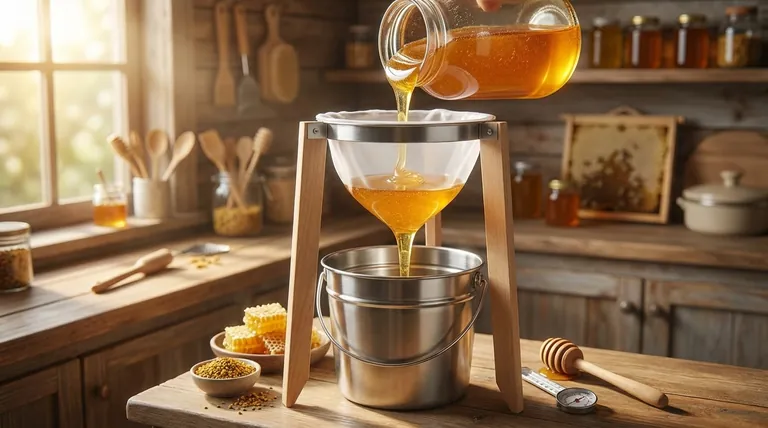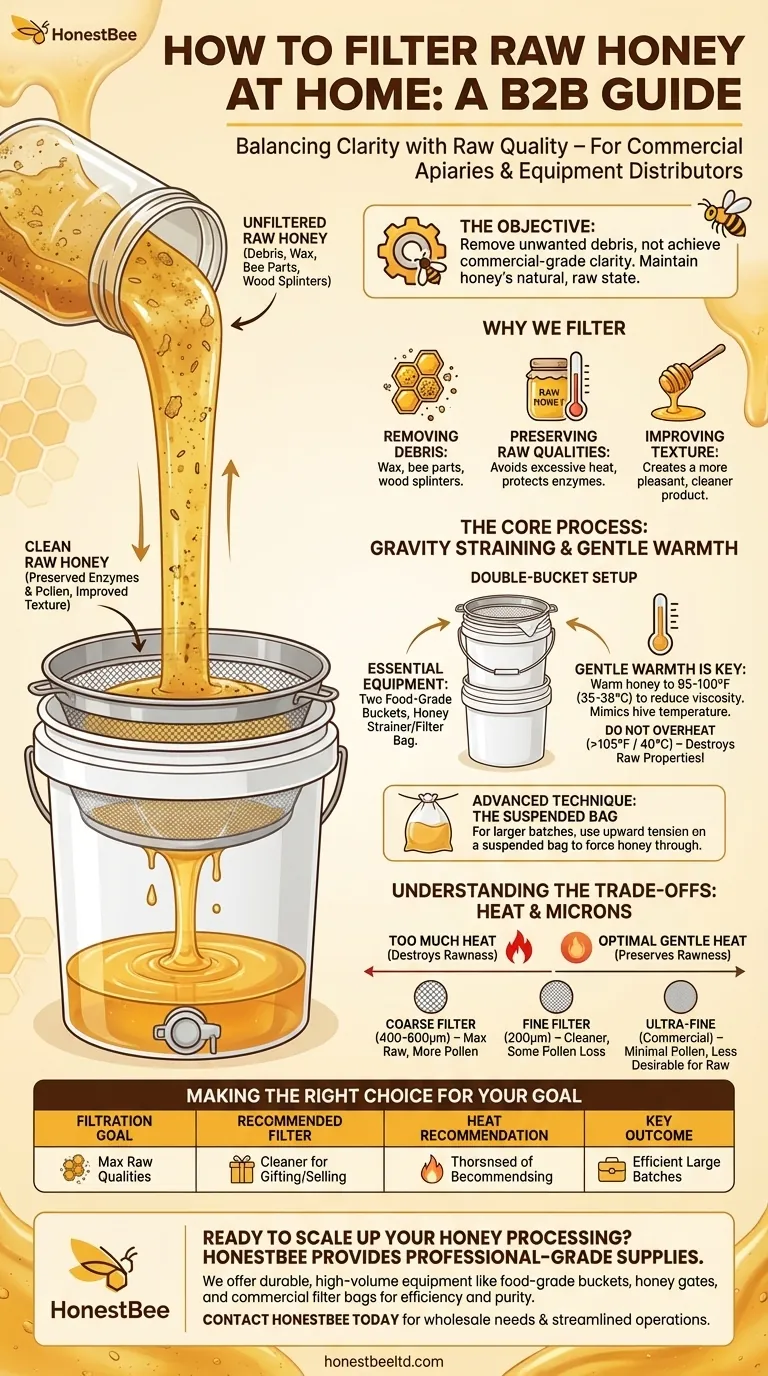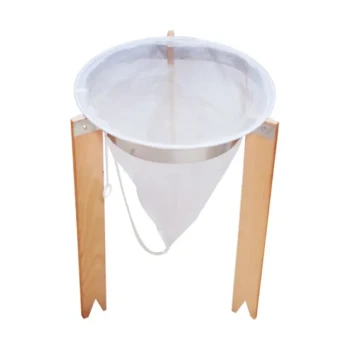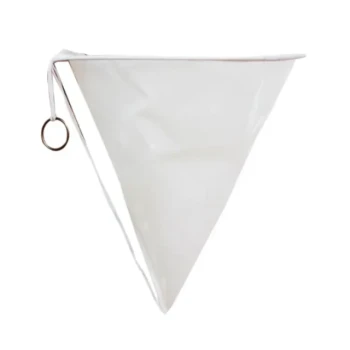To filter raw honey at home, you pour it through a mesh screen or filter bag placed over a clean, food-grade bucket. The process relies on gravity to separate the liquid honey from solid debris like wax cappings, bee parts, and wood splinters from the hive frames. This simple technique ensures the honey is clean enough for bottling while preserving its natural, raw qualities.
The objective of filtering raw honey is not to achieve commercial-grade clarity, but to remove unwanted debris. The core challenge is managing honey's high viscosity, which can be addressed with gentle warming and the right equipment.

Why We Filter Raw Honey
Filtering is a necessary step after honey extraction. It's the final stage of cleaning before the honey is ready for storage or consumption.
Removing Extraction Debris
The primary goal is to remove visible particles left over from the uncapping and extraction process. This includes bits of beeswax, parts of bees, and small splinters of wood.
Preserving Raw Qualities
Proper filtering does not alter the honey's state. It remains raw, meaning it hasn't been pasteurized or heated excessively, which would destroy beneficial enzymes and pollen.
Improving Texture and Appearance
While some cloudiness from pollen is desirable in raw honey, removing larger wax particles creates a more pleasant texture and a cleaner final product for the jar.
The Core Filtration Process: Gravity Straining
The most common and effective method for home beekeepers uses a simple double-bucket system. It's low-cost and highly effective.
Essential Equipment
You only need a few items: two clean, food-grade buckets, and a honey strainer or filter bag. Strainers are often made of stainless steel mesh and can be stacked with coarse and fine layers.
The Double-Bucket Setup
Place the first bucket on the floor. This will be your collection bucket.
Place the second bucket, which has a honey gate (spigot) at the bottom, directly on top of the first. Drape your filter bag into this top bucket or place your mesh strainer over it.
The Importance of Gentle Warmth
Raw honey is thick and filters very slowly. To speed things up, you can warm the honey slightly to between 95-100°F (35-38°C). This mimics the natural temperature inside a beehive and makes the honey much less viscous.
You can achieve this by placing your honey bucket in a warm water bath or using a heated "honey warming blanket."
An Advanced Technique: The Suspended Bag
For larger batches, you can pour the honey into a large filter bag that is suspended inside your bottling bucket.
As described in one technique, you can tie off the top of the bag and attach a bungee cord to slowly pull the bag upwards. This upward tension helps force the honey through the filter mesh as the collected debris rises with the bag.
Understanding the Trade-offs
Filtering honey involves balancing purity with its raw, natural state. Your choices in the process matter.
Heat: The Enemy of Raw Honey
The single biggest mistake is overheating. Heating honey above approximately 105°F (40°C) begins to destroy the delicate enzymes and beneficial compounds that define it as "raw." Always use low, gentle heat.
Filtration Level vs. Pollen Content
Honey strainers are measured in microns. A coarse filter (e.g., 400-600 microns) will remove wax and large debris but leave most of the beneficial pollen.
A fine filter (e.g., 200 microns) will produce a clearer honey but may also strip out some of the pollen grains. Ultra-fine commercial filtering is what removes almost all pollen, which is not desirable for raw honey.
Making the Right Choice for Your Goal
Your ideal filtering method depends on what you value most in your final product.
- If your primary focus is preserving the maximum raw qualities: Use a single, coarse filter (around 600 microns) with no heat at all, and be patient as it slowly drips through.
- If your primary focus is a cleaner honey for gifting or selling: Use a double-strainer system (e.g., 600 micron on top of a 200 micron) and gently warm the honey to hive temperature.
- If your primary focus is processing a large batch efficiently: The suspended bag method combined with gentle warming is an excellent way to handle higher volumes without constant supervision.
Ultimately, filtering is the simple, final step to prepare the pure, delicious honey your bees worked so hard to produce.
Summary Table:
| Filtration Goal | Recommended Filter Micron | Heat Recommendation | Key Outcome |
|---|---|---|---|
| Max Raw Qualities | Coarse (600μm) | No heat | Preserves most pollen & enzymes |
| Cleaner for Gifting/Selling | Double (600μm + 200μm) | Gentle (95-100°F / 35-38°C) | Cleaner appearance, good pollen retention |
| Efficient Large Batches | Filter Bag | Gentle (95-100°F / 35-38°C) | Faster processing for higher volumes |
Ready to scale up your honey processing?
Whether you're a commercial apiary managing hundreds of hives or a beekeeping equipment distributor, HONESTBEE has the professional-grade supplies you need. We provide durable, high-volume equipment like food-grade buckets, honey gates, and commercial filter bags designed for efficiency and purity.
Let us help you streamline your operation and maintain the highest quality raw honey.
Contact HONESTBEE today to discuss your wholesale needs!
Visual Guide

Related Products
- Professional Honey Filter with Tripod Support Stand
- Professional Cone-Shaped Honey Filter with Reinforced Steel Ring
- Nylon Honey Strainer Square Filter Cloth for Honey Filters
- Two-Stage Plastic Honey Filter for Buckets
- Professional Stainless Steel Honey Filter with Support Handle
People Also Ask
- What are the benefits of drying honey filtering equipment after use? Protect Your Honey Quality & Equipment Investment
- Why is filtering honey considered an essential step in honey processing? Ensure Quality and Commercial Viability
- Why is it important to inspect and replace filters in honey filtering equipment? Protect Your Honey Quality & Equipment
- Why is filtering honey an important step in honey processing? Ensure Purity, Clarity & Marketability
- What filter size for honey? A Beekeeper's Guide to Straining for Clarity and Quality



















